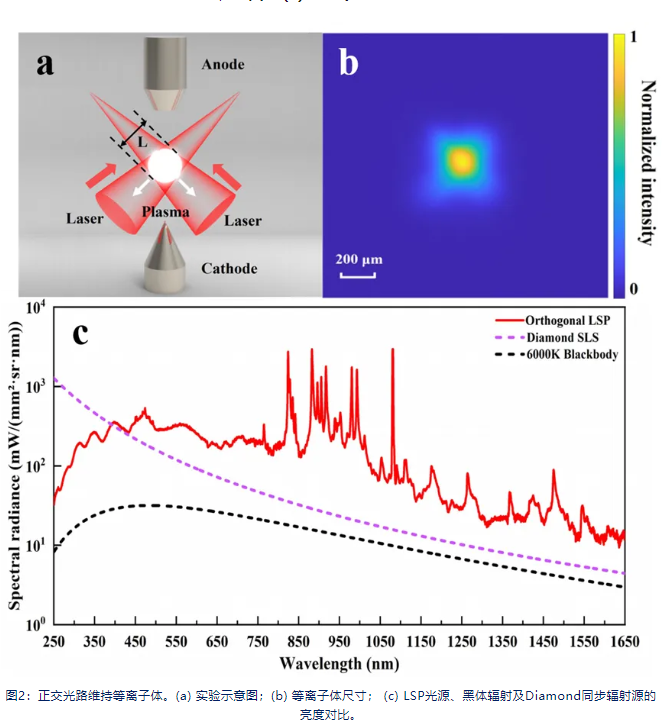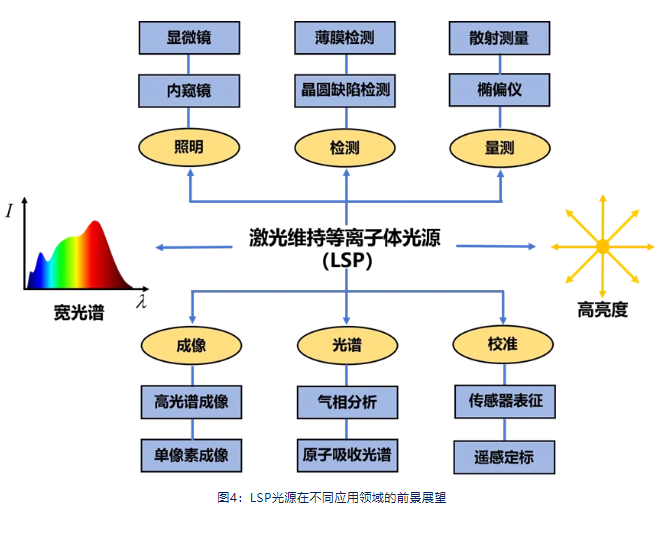02
2024
-
11
High Brightness UV-Visible-Infrared Wide Spectrum Light Source
Author:
Beijing University of Aeronautics and AstronauticsResearch Group of Professor Yu XiaA miniaturized, high-brightness incoherent broad-spectrum light source is successfully developed, whose spectral range covers the ultraviolet-visible-infrared band. The team proposed an orthogonal laser light path to maintain the plasma technology, which effectively suppressed the negative lens deflection effect of the plasma on the laser, and achieved a high-brightness and high-efficiency broad-spectrum light source under laboratory conditions.
broad spectrum light sourceIt is the core component of testing equipment in the fields of biomedicine, material characterization, aerospace and semiconductors. As the "light in the eye" of intelligent equipment, its brightness, shortest wavelength and spectral coverage directly affect the detection speed, sensitivity and the type of detectable materials. In addition, reducing the coherence of the light source can effectively reduce the speckle phenomenon in optical imaging. traditional incoherent broad-spectrum light sources, suchFigure 1It mainly includes a thermal radiation light source represented by a halogen lamp, an electroluminescent light source represented by an LED, and a gas discharge light source represented by a xenon lamp.

In the field of light sources, researchers have never stopped pursuing higher brightness.laser-sustained plasma(LSP, laser-sustained plasma) works by first generating an initial plasma through methods such as arc discharge, and then focusing a continuous laser to the plasma, relying only on the laser to provide the energy needed to maintain the plasma. As a further application of gas discharge technology in the optical frequency domain, LSP can effectively enhance the energy absorption of the high-density core region in the plasma, so as to achieve a smaller size and higher temperature plasma, and thus make the brightness beyond the traditional xenon lamp.
The brightness of the LSP light source depends mainly on the radiation power and the size of the plasma. Intuitively, increasing the laser power appears to increase the radiation power of the plasma. However, as the laser power increases, the size of the plasma also increases, resulting in the brightness of the LSP light source is not significantly improved. More importantly, the plasma will exhibit a negative lens effect, causing the laser to refract and defocus in the plasma. With the further increase of the laser power, the deflection effect becomes more and more significant, which leads to the decrease of the power density of the laser in the plasma, thus reducing the energy conversion efficiency of the interaction between the plasma and the laser.Therefore, suppressing the size growth of plasma with the increase of laser power becomes a key challenge to realize high brightness and wide spectrum light source.
Professor Yu Xia's research group of Beijing University of Aeronautics and Astronautics has designed suchFigure 2(a)The orthogonal laser light path is shown to reasonably share the influence of laser power on the growth of plasma size, thus significantly suppressing the refraction defocusing effect of plasma. SuchFigure 2 (B)As shown, the plasma shape maintained by the orthogonal laser light path is more symmetrical, and the growth rate of the plasma size with the laser power is also significantly suppressed. The negative lens deflection effect of this small size plasma on the laser is nearly eliminated, and more laser light is absorbed by the plasma, and the higher temperature plasma is confined to a smaller spatial range. Therefore, the brightness of the light source is greatly improved, and it can even be comparable to some synchrotron radiation light sources in multiple bands, suchFigure 2(c)shown.

In order to demonstrate the advantages of this high-brightness, miniaturized wide-spectrum light source, the team members applied the LSP light source prototype to a single-phase pixel spectral imaging system. Under the premise of ensuring the imaging quality, the light source significantly shortens the integration time of the reconstructed image, which strongly promotes the development of high temporal resolution spectral imaging technology.

Miniaturized, high-brightness broad-spectrum light sources have shown broad application prospects in many industrial and field testing fields, suchFigure 4shown. In addition, in the frontier fields of quantum optical imaging, computational imaging and optical computing, this incoherent, high-power light source is expected to eliminate the speckle problem in imaging and the phase noise problem in optical computing. Of course, in the development of this technology, there are still many challenges waiting for us to explore in many aspects, such as the stability of time domain and space domain, high-pressure plasma technology, beam shaping technology and coating technology.
The road is long, and the line will come. The future can be expected without stopping.

Chongqing Chongfan Technology Co., Ltd. Optical platform film thickness meter OCT optical coherence tomography LabVIEW control
LATEST NEWS
2024-10-05
Calculation of the diffracted light field: Regarding Fresnel near-field diffraction, how should the field distribution be calculated after a plane wave encounters a metasurface and experiences a phase jump?
Previously, a friend wanted to see the source code for the article 'Matlab Optical Fresnel Diffraction, Dynamic Visualization of Matlab Curves and Graphics', and the source code is included in this article.
2024-11-15
Academician Chang Ruihua's team has made new progress in short-distance optical communication high-speed interconnection technology.
850nm wavelength multimode vertical-cavity surface-emitting lasers (VCSELs) and multimode fibers (MMFs) have become the ideal choice for short-distance optical interconnects in data centers and supercomputing systems due to their low power consumption and cost-effectiveness.
2024-11-18
Wide spectrum heterojunction self-powered photodetector with linear and circular polarization detection capabilities
Two-dimensional (2D) materials have become a hot research topic due to their unique mechanical, optical and physical properties such as broadband response range, layer-dependent band gap, tunable electronic and optical properties, and high carrier mobility.
2024-11-07
Spin-based Schrodinger Cat States Prepared by Laser Cold Atom Method
The spin-based Schrodinger cat state is prepared by laser cold atom method, and its lifetime reaches the order of minutes, which helps to improve the measurement sensitivity of spin precession phase.

